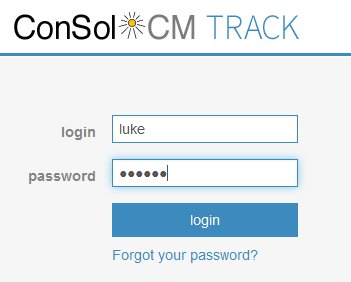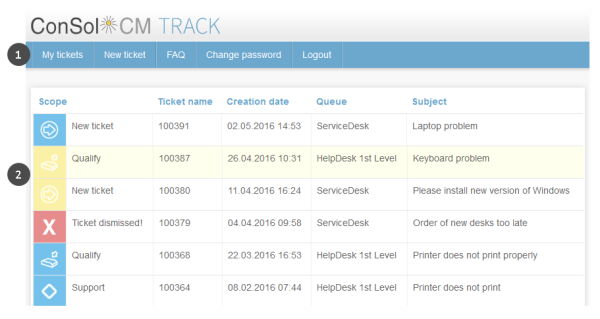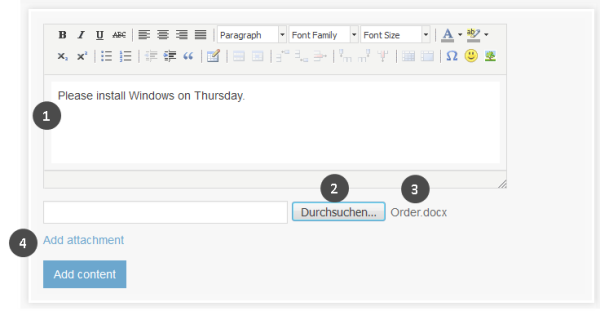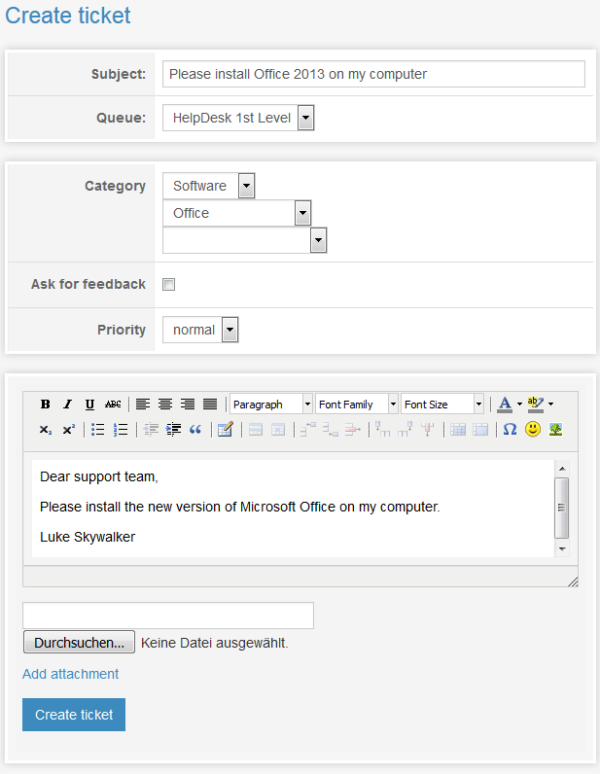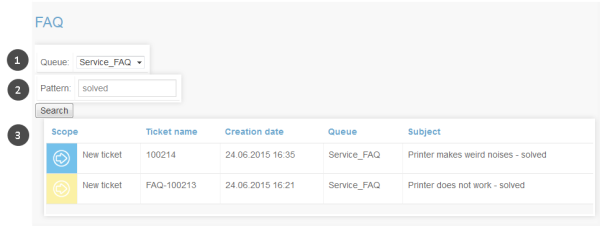CM.Track V1 from Your Customers' Point of View
This section deals exclusively with the external side of CM.Track, i.e., how your customers work with CM.Track. Please see Configuring CM.Track V1 for Your Customers and Considering CM.Track V1 When Working with Tickets for your tasks concerning CM.Track. As an engineer, you do not need to log in to CM.Track, you always work with the Web Client.
Logging in to CM.Track
The CM.Track login page can be embedded into your company's website or can be a website on its own. Your CM administrator can tell you the URL.
Customers can log in to CM.Track by providing their user name and password. These login data are part of their CM.Track account.
Figure 132: Customer login to CM.Track
Viewing the Ticket List in CM.Track
The overview screen is displayed when the customer logged in to CM.Track. It consists of a menu bar (1) and the ticket list (2).
Figure 133: Overview screen of CM.Track
The menu bar contains links to different features. The available links depend on the individual configuration of your CM system. The following links are available in a standard setup:
- My tickets
Opens the overview with the ticket list. - New ticket
Opens the screen where the customer can create a new ticket. - FAQ
Opens the FAQ search screen. - Change password
Opens a screen where the customer can change his password. - Logout
Logs the customer out of CM.Track
The ticket list contains the tickets which the customer is allowed to view. For each ticket the following information is provided:
- Scope
Displays the current scope of the ticket (in the workflow) and the ticket icon. - Ticket name
Displays the unique ticket name. - Creation date
Displays the date and time when the ticket was created. - Queue
Displays the current queue of the ticket. - Subject
Displays the subject of the ticket.
The customer can sort the ticket list by column.
Which Tickets are Displayed in the Customer's Ticket List?
The tickets displayed in the ticket list depend on the CM.Track profile which you assigned to the CM.Track account. Depending on the permissions included in the profile, the customer can see either:
- Own tickets
All tickets where the customer is the main customer or an additional customer. - Own and company tickets
All tickets where the customer, another contact of the company which the customer belongs to, or the company itself is the main customer or an additional customer.
Working with Tickets in CM.Track
Viewing a Ticket in CM.Track
Customers can view the details of a ticket by opening the ticket. They just have to click the row of the ticket in the ticket list. The ticket details contain standard ticket data at the top (1) and additional ticket data below (2). The comments (3) are displayed below the ticket data. At the bottom, there is a button which the customer can use to add comments and attachments (4).
Figure 134: Ticket details
The customer can return to the overview containing the ticket list by clicking My tickets in the menu bar.
Adding Content to a Ticket in CM.Track
Customers can add comments and attachments to their tickets using CM.Track. To do so, they have to open the respective ticket and click the Add content button. This opens the editor shown in the following figure.
Figure 135: Editor to add content to a ticket
The customer can perform the following actions:
- Write a comment (1)
The customer can use the Rich Text Editor to enter his comment. - Browse for a file to upload an attachment (2)
The uploaded file (3) is displayed next to the browse button (here Order.docx). The customer can change the file by clicking the browse button and selecting another file. - Add another attachment (4)
If the customer wants to add another attachment, he can click the Add attachment button. A new row with a browse button is displayed where the customer can select another file.
The customer has to click Add content to save his changes. Usually, the comments and attachments are directly visible in CM.Track.
Figure 136: Added content visible in CM.Track
As an engineer, you can see your customers' comments and attachments in the Web Client, see Customers Add Content to an Existing Ticket in CM.Track in CM.Track.
Creating a Ticket in CM.Track
Customers can create new tickets using CM.Track provided that their CM.Track profile contains the required permissions. They have to carry out the following steps:
- The customer clicks New ticket in the main menu.
- The customer fills out the data fields on the Create ticket screen. He can add a comment or attachment.
- The customer clicks the Create ticket button to save the ticket.
Figure 137: Creating a new ticket in CM.Track
As an engineer, you can see the new ticket in the Web Client, see Customers Create New Tickets in CM.Track.
In the standard configuration, the customer sees the same fields in CM.Track as you, as an engineer, see in the Web Client.
Searching the FAQs
FAQs (Frequently Asked Questions) help your customers to find answers to common questions by themselves. FAQs are managed as tickets within your CM system, where FAQ tickets are located in a special FAQ queue. In contrast to normal tickets, which are visible to their customers only, FAQ tickets are visible to all customers in CM.Track. FAQ tickets can contain solutions to known problems or instructions on common tasks.
It depends on the individual configuration of your CM system whether the FAQ functionality is available.
Your customers can search the FAQ by proceeding as follows:
- The customer clicks FAQ in the menu bar.
- On the FAQ screen, the customer selects a queue (1), enters a search pattern (2), and clicks the Search button.
- The matching FAQ tickets are displayed in the ticket list (3) and the customer can click a ticket to open its details.
Figure 138: Searching the FAQ
It is possible to use an asterisk (*) as a wildcard in the search pattern.
Changing the Password
Your CM system can be configured to allow your customers to change their CM.Track password within CM.Track. In this case, the menu bar includes a link for password change.
The customers can change their password by clicking the Change password link, and entering the old and new passwords into the respective fields. Afterwards, they have to click the Change password button to save their changes.
Figure 139: Changing the password
